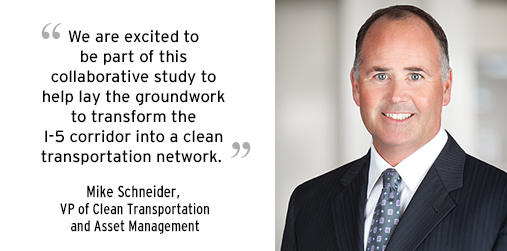In California, the transportation sector accounts for nearly 80% of the state’s air pollution and more than 40% of all greenhouse gas emissions. Washington and Oregon face similar environmental challenges, transportation being the largest contributor to air pollution and greenhouse gas emissions in those states as well.
Today, electricity providers in the three West Coast states, including SDG&E, announced that they are working on a solution to significantly curb those harmful emissions.
Nine electric utilities and two agencies representing more than two dozen municipal utilities are sponsoring the West Coast Clean Transit Corridor Initiative, a study to determine how best to ensure that Interstate 5 — a lifeline of goods transportation that extends more than 1,300 miles from the Canadian to the Mexican border — is equipped with sufficient charging to support electric long-haul trucks.

“Many of the utilities represented in this partnership have programs to support charging electric vehicles that travel within our own territories, but for extended shipping and long-haul trucks, we need solutions that we can apply across utility territories,” said Caroline Choi, senior vice president of Corporate Affairs for Edison International and Southern California Edison, one of the utilities sponsoring the study.
The study will explore how best to provide EV charging on I-5 and its connecting routes for medium- and heavy-duty electric trucks that are being introduced by several major vehicle manufacturers, as well as to help determine what role electricity providers can play in electrifying the corridor. Key locations for electric truck charging infrastructure will also be identified and prioritized.
“Big challenges require bold and collaborative solutions, and climate change is such a challenge,” said Emeka Anyanwu, Energy Innovation & Resources officer for Seattle City Light, another study sponsor. “So it is exciting to see such a wide range of experience and diversity of thinking from our various utilities being brought to bear to tackle such a critical issue.”
Other initiative sponsors are Los Angeles Department of Water & Power, Northern California Power Agency, Pacific Gas and Electric Company, Pacific Power, Portland General Electric, Puget Sound Energy, Sacramento Municipal Utility District, and Southern California Public Power Authority.
“Well-planned electric charging infrastructure along I-5 is important to our region,” said Scott Bolton, senior vice president of External Affairs for Pacific Power. “The I-5 corridor is the economic backbone for transporting essential goods and services to our Oregon, Washington and California customers. We see investments in transportation electrification and electric charging infrastructure as a great way to support the economic vitality and environmental quality of communities along the corridor.”
Those benefits include improved health. Data shows that people who live near truck-traffic corridors experience higher rates of asthma, lung and heart disease and chronic bronchitis due largely to breathing toxic vehicle emissions, specifically diesel particulate matter.
“We are excited to be part of this collaborative study to help lay the groundwork to transform the I-5 corridor into a clean transportation network,” said Mike Schneider, vice president of clean transportation and asset management at SDG&E. “Communities located along busy trucking routes are often communities of concern because they suffer from disproportionately high levels of pollution and diseases associated with pollution, such as asthma.”
The study is expected to be concluded by year’s end, with implementation of recommendations expected to begin as soon as next year.